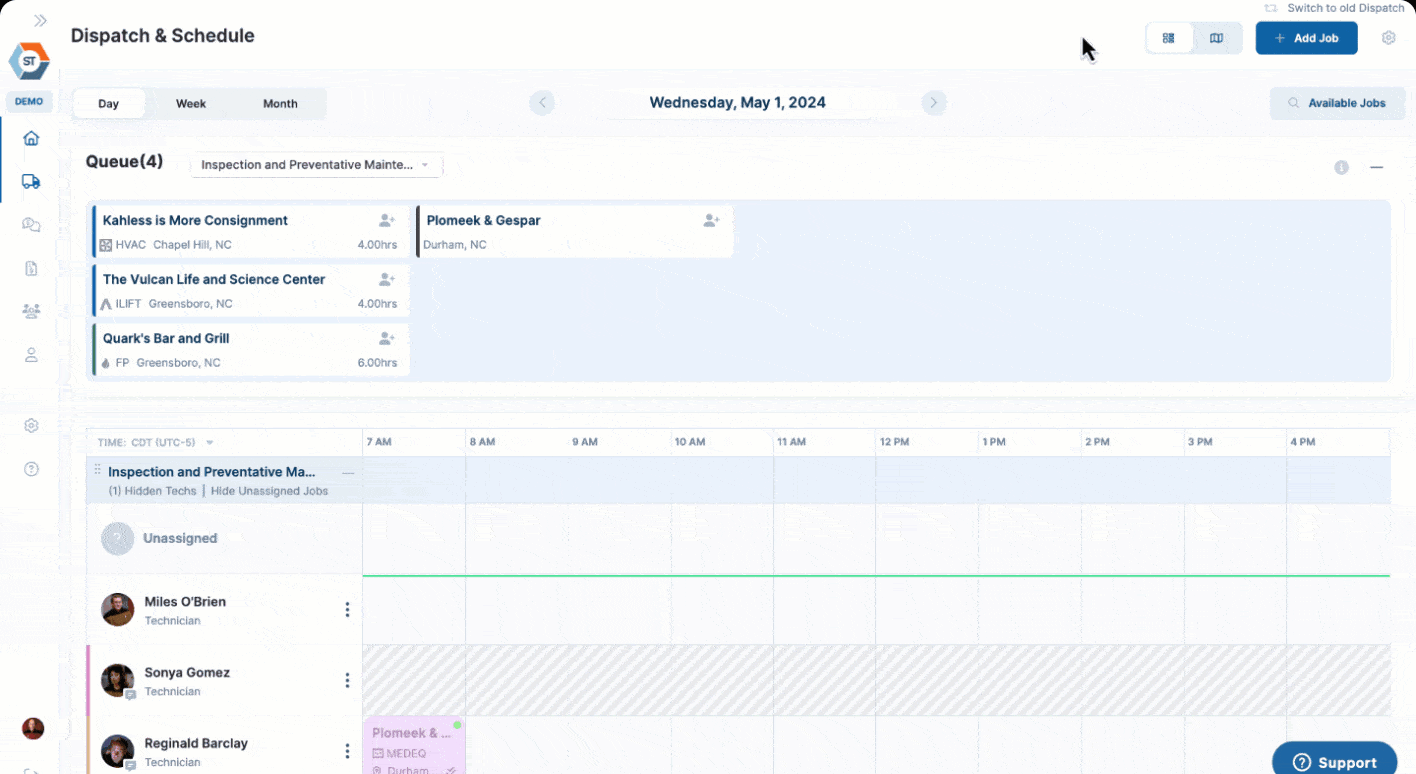Achieving Peak Efficiency: The 5 Benefits of Automated HVAC Scheduling
In the commercial HVAC service industry, efficiency is king. The ability to manage appointments, dispatch technicians, allocate resources, and communicate with customers in a streamlined, timely manner is critical to the success of any business. The good news is that with the advent of automated HVAC scheduling, service providers now have access to comprehensive software solutions that can help them achieve peak efficiency and stay ahead of the competition.
This article will explore the benefits of automated HVAC scheduling and how it can transform business operations. We’ll discuss the features and functionality service providers should look for in scheduling software and offer actionable tips for optimizing its use. Whether you’re just getting started with automated scheduling or looking for ways to improve current operations, this guide will provide valuable insights and practical advice for achieving maximum efficiency.
Streamlined Appointment Booking and Dispatching
Manual appointment booking and dispatching processes are often time-consuming and vulnerable to errors. Automating these tasks through HVAC scheduling software simplifies the process, reduces errors, and saves time. With the help of software, customers can quickly book appointments online with an intuitive and easy-to-use interface. Automating this process saves providers enormous time and allows their representatives to focus on other tasks that support their business’s growth.
After receiving an appointment booking, the software allocates the date and time and assigns the job to a technician based on availability, location, and skillset. This optimization allows service providers to maximize their resources and better serve their customers, all while ensuring predictable scheduling around specific events, such as routine maintenance and system failure responses. The software can also modernize dispatching, leading to the rapid response times that customers expect, and can reduce the potential risk of service requests being double-booked or lost in manual processes. As the software handles most dispatching tasks, customer inquiries regarding their technician’s ETA can be answered in real-time by customer service representatives with the click of a button. Such a response often positively impresses the customer, leading to higher rates of satisfaction and increased repeat business.
Furthermore, automated scheduling’s real-time tracking and updating of job assignments enables providers to optimize their resources. Since the software provides a database of technicians and their skill sets, service providers can identify and match the necessary skill set for each job, ensuring a high level of quality and expertise. Such functionality strengthens resource allocation, ensures predictability, and reduces the chances of an HVAC technician arriving at a job ill-equipped to address someone’s needs. Also, having precise information regarding technician location often helps improve job allocation, reduces response times, and improves customer satisfaction.
Efficient Resource Allocation
Modern automated HVAC scheduling software enables service providers to optimize resources easily. The software combines intelligent algorithms with comprehensive information on a company’s technicians, customers, and equipment to intuitively allocate assignments. This eliminates unnecessary downtime caused by underutilized or overbooked technicians and helps optimize repair and maintenance schedules. As a result, providers can deliver prompt services while saving time and money.
The software integrates all key factors that help better allocate resources, including scheduling preventive maintenance visits required on specific dates, such as cleaning, inspection, or testing visits. Automated scheduling systems inform customers about upcoming routine visits and let service providers know when the next service is due, enabling them to optimize the workload of their technicians and better allocate resources.
Real-Time Updates and Communication
One of the critical components of the automated scheduling system is real-time communication. Automated scheduling software allows customers to receive regular updates and appointment reminders via email, text, or automated calls. Technicians can access detailed and specific information on their tasks, including scheduling and other job details, on their mobile devices. This means they can quickly communicate with customers and inform them of any issues as soon as they arise.
Real-time communication enables service providers to be proactive, quickly respond to customer requests, and jump on opportunities as they arise. This also leads to better customer service and helps customers feel more engaged and involved in the repair or maintenance process.
Data-driven Decision Making
Automated HVAC scheduling systems’ data insights provide a unique opportunity for service providers to optimize their operations by analyzing trends, observing patterns, and evaluating performance data. The software generates reports that showcase essential metrics, insights, and information regarding the business’s overall performance, including customer feedback, missed opportunities, job allocation pacing, technician utilization rates, and pricing trends.
Using such data, service providers can anticipate demand patterns and optimize their pricing and invoicing models while ensuring that each job is assigned to the best technician for the job. This is critical in an industry where service pricing can fluctuate based on the demand and the number of jobs performed. Historical data reports generated by the software offer insights into peak season and holiday trends, allowing providers to allocate resources accordingly and avoid customer satisfaction pitfalls.
In addition, automated scheduling systems provide visibility into customer satisfaction rates. These data insights help service providers make informed decisions about their businesses, pricing, and offerings. Monitoring customer satisfaction metrics such as response times or technician assignment rates can assist providers with identifying underperforming areas, enabling corrective action, and driving improvements overall. Acting on such data-driven insights optimizes service performance, results in higher-quality customer experiences, and ultimately drives profitability.
Improved Customer Experience
A well-functioning, automated HVAC scheduling system is designed to enhance the customer experience by providing a hassle-free and transparent service. When scheduling appointments manually, customers may experience delays or miscommunications, leading to frustration and a negative perception of the service provider. However, with an automated scheduling system, customers can quickly and easily book appointments online at their convenience, using an intuitive interface. This eliminates the need for lengthy phone calls or waiting for business hours to make an appointment.
In addition to simplified appointment bookings, an automated scheduling system enables customers to receive real-time updates on their appointments. This feature provides transparency and peace of mind, as customers can stay informed about the status of their appointments and any potential changes or delays. The system can automatically send appointment reminders and notifications via email or text, ensuring that customers are prepared and ready for their scheduled service. This proactive communication builds trust and confidence in the service provider, reinforcing a positive customer experience.
Moreover, by incorporating mobile devices into the automated scheduling system, service providers can enhance communication between customers and technicians. This allows customers to easily communicate with their assigned technician before, during, or after a service appointment. They can ask questions, provide additional information, or address any concerns they may have. This direct line of communication promotes transparency, improves customer satisfaction, and fosters a sense of trust and partnership between the service provider and the customer.
Challenges and Considerations
Implementing an automated HVAC scheduling system can come with challenges. Business owners must be mindful of privacy and security issues and comply with data protection regulations. Service providers must ensure that the software they choose is tailored to their specific requirements and is scalable enough to match future business growth.
Another consideration is the cost of implementing such a system. Providers need to assess the impact of adopting a scheduling system on their bottom line. The good news is that with the increasing availability of software solutions, the costs have been falling, and service providers can choose from several options designed for their specific business needs.
Automated HVAC scheduling systems have transformed how commercial service providers manage their operations. This technology benefits the service provider tremendously, providing appointment optimization, dispatching, resource allocation, accurate pricing, business intelligence, and enhanced communication and customer service. For the customer, the benefits include hassle-free booking, swift communication, and access to technician information. By being proactive and embracing new technologies, your business can transform operations, stay ahead of the competition, and reach peak efficiency.
Learn about ServiceTrade’s HVAC software here.

